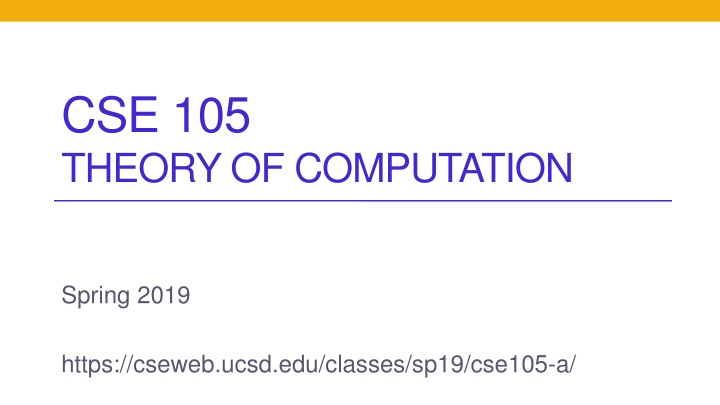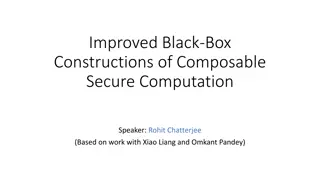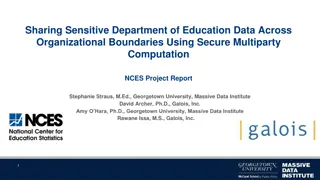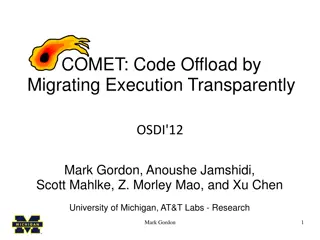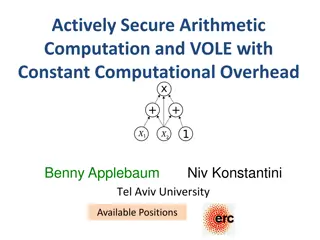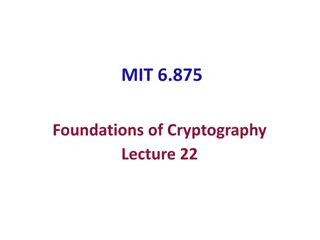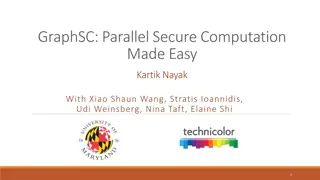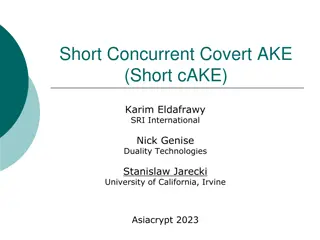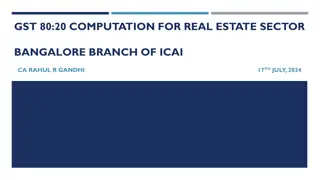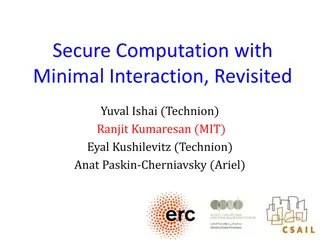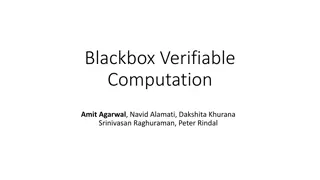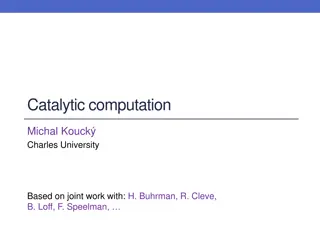Theory of Computation - Spring 2019 Highlights
Dive into the world of Theory of Computation with a focus on Turing machines, recognizable and decidable sets, and the Church-Turing thesis. Explore the construction and properties of Turing machines, different levels of descriptions, and the expressive power of various machine variants. Delve into examples and concepts like zig-zag tape traversals, decidability, and formal definitions of Turing machines.
Uploaded on Apr 19, 2025 | 1 Views
Download Presentation

Please find below an Image/Link to download the presentation.
The content on the website is provided AS IS for your information and personal use only. It may not be sold, licensed, or shared on other websites without obtaining consent from the author.If you encounter any issues during the download, it is possible that the publisher has removed the file from their server.
You are allowed to download the files provided on this website for personal or commercial use, subject to the condition that they are used lawfully. All files are the property of their respective owners.
The content on the website is provided AS IS for your information and personal use only. It may not be sold, licensed, or shared on other websites without obtaining consent from the author.
E N D
Presentation Transcript
CSE 105 THEORY OF COMPUTATION Spring 2019 https://cseweb.ucsd.edu/classes/sp19/cse105-a/
Today's learning goals SipserCh 3.1, 3.2 Design TMs using different levels of descriptions. Give high-level description for TMs (recognizers and enumerators) used in constructions Prove properties of the classes of recognizable and decidable sets. Describe several variants of Turing machines and informally explain why they are equally expressive. State and use the Church-Turing thesis.
An example L = { w#w | w is in {0,1}* } Idea for Turing machine Zig-zag across tape to corresponding positions on either side of '#' to check whether these positions agree. If they do not, or if there is no '#', reject. If they do, cross them off. Once all symbols to the left of the '#' are crossed off, check for any symbols to the right of '#': if there are any, reject; if there aren't, accept. How would you use this machine to prove that L is decidable?
Q={q1,q2,q3,q4,q5,q6,q7, q8,qaccept,qreject} = {0,1,#} = {0,1,#,x,_ } All missing transitions have output (qreject, _, R) Fig 3.10 in Sipser
Computation on input 0#0? Configuration u q v for current tape uv (and then all blanks), current head location is first symbol of v, current state q
Describing TMs Sipser p. 159 Formal definition: set of states, input alphabet, tape alphabet, transition function, state state, accept state, reject state. Implementation-level definition: English prose to describe Turing machine head movements relative to contents of tape. High-level desciption: Description of algorithm, without implementation details of machine. As part of this description, can "call" and run another TM as a subroutine.
An example Which of the following is an implementation-level description of a TM which decides the empty set? M = "On input w: A. reject." B. sweep right across the tape until find a non-blank symbol. Then, reject." C. If the first tape symbol is blank, accept. Otherwise, reject." D. More than one of the above. E. I don't know.
Turing recognizable languages Turing decidable languages Context-free languages Regular languages
Closure Theorem: The class of decidable languages over fixed alphabet is closed under union. Proof: Let WTS
Closure Theorem: The class of decidable languages over fixed alphabet is closed under union. Proof: Let L1 and L2 be languages over and suppose M1 and M2 are TMs deciding these languages. We will define a new TM, M, via a high-level description. We will then show that L(M) = L1 U L2 and that M always halts.
Closure Theorem: The class of decidable languages over fixed alphabet is closed under union. Proof: Let L1 and L2 be languages and suppose M1 and M2 are TMs deciding these languages. Construct the TM M as "On input w, 1. Run M1 on input w. If M1 accepts w, accept. Otherwise, go to 2. 2. Run M2 on input w. If M2 accepts w, accept. Otherwise, reject." Correctness of construction: WTS L(M) = L1 U L2 and M is a decider. Where do we use decidability?
Closure The class of decidable languages is closed under Union Concatenation Intersection Kleene star Complementation Good exercises can't use without proof! (Sipser 3.15, 3.16) The class of recognizable languages is closed under Union Concatenation Intersection Kleene star
Variants of TMs Section 3.2 Scratch work, copy input, Parallel computation Printing vs. accepting More flexible transition function Can "stay put" Can "get stuck" lots of examples in exercises to Chapter 3 Multiple tapes Nondeterminism Enumerators Payoff: in high-level description of TM, can simulate converstion to other variant.
"Equally expressive" Model 1 Model 2 Model 1 is equally expressive as Model 2 iff every language recognized by some machine in Model 1 is recognizable by some machine in Model 2, and every language recognized by some machine in Model 2 is recognizable by some machine in Model 1.
Nondeterministic TMs Sipser p. 178 Transition function Q x P(Q x x {L,R}) Sketch of proof of equivalence: A. Given TM, build nondeterminstic TM recognizing same language. B. Given nondeterministic TM, build (deterministic) TM recognizing same language. Idea: Try all possible branches of nondeterministic computation. 3 tapes: "read-only" input tape, simulation tape, tape tracking nondeterministic braching.
Multitape TMs Sipser p. 176 As part of construction of machine, declare some finite number of tapes that are available. Input given on tape 1, rest of the tapes start blank. Each tape has its own read/write head. Transition function Q x k Q x k x {L,R}k Sketch of proof of equivalence: Given TM, build multitape TM recognizing same language. Given k-tape TM, build (1-tape) TM recognizing same language. Idea: Use delimiter to keep tape contents separate, use special symbol to indicate location of each read/write head
Very different model: Enumerators Sipser p. 180 Produce language as output rather than recognize input Computation proceeds according to transition function. Finite State Control At any point, machine may "send" a string to printer. a b a b . Unlimited work tape L(E) = { w | E eventually, in finite time, prints w} Printer
Enumerators Can L(E) be infinite? A. No, strings must be printed in finite time. B. No, strings must be all be finite length. C. Yes, it may happen if E does not halt. What about machines that produce output rather than accept input? D. Yes, all L(E) are infinite. E. I don't know. Computation proceeds according to transition function. Finite State Control At any point, machine may "send" a string to printer. a b a b . Unlimited tape L(E) = { w | E eventually, in finite time, prints w}
Set of all strings "For each , there is an enumerator whose language is the set of all strings over ." A. True B. False C. Depends on . D. I don't know.
Set of all strings "For each , there is an enumerator whose language is the set of all strings over ." A. True B. False C. Depends on . D. I don't know. Standard string ordering: order strings first by length, then dictionary order. (p. 14)
Recognition and enumeration Sipser Theorem 3.21 Theorem: A language L is Turing-recognizable iff some enumerator enumerates L. Proof: Assume L is Turing-recognizable. WTS some enumerator enumerates it. Assume L is enumerated by some enumerator. WTS L is Turing-recognizable.
Recognition and enumeration Sipser Theorem 3.21 Assume the enumerator E enumerates L. WTS L is Turing- recognizable. We'll use E in a subroutine for high-level description of Turing machine M that will recognize L. Define M as follows: M = "On input w, 1. Run E. Every time E prints a string, compare it to w. 2. If w ever appears as the output of E, accept. Correctness?
Recognition and enumeration Sipser Theorem 3.21 Assume L is Turing-recognizable. WTS some enumerator enumerates it. Let M be a TM that recognizes L. We'll use M in a subroutine for high- level description of enumerator E. Let s1, s2, be a list of all possible strings of *. Define E as follows: E = "Repeat the following for each value of i=1,2,3 1. Run M for i steps on each input s1, , si 2. If any of the i computations of M accepts, print out the accepted string. Correctness?
Variants of TMs Scratch work, copy input, Parallel computation Printing vs. accepting More flexible transition function Can "stay put" Can "get stuck" lots of examples in exercises to Chapter 3 Multiple tapes Nondeterminism Enumerators All these models are equally expressive! Also: wildly different models -calculus, Post canonical systems, URMs, etc.
Church-Turing thesis Sipser p. 183 Wikipedia "self-contained step-by-step set of operations to be performed" CSE 20 textbook "An algorithm is a finite sequence of precise instructions for performing a computation or for solving a problem." Each algorithm can be implemented by some Turing machine. Church-Turing thesis
